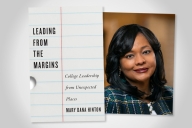You have /5 articles left.
Sign up for a free account or log in.
Not a week goes by without a racial incident on some campus or another. Court cases about affirmative action generate widespread debate. Many colleges struggle to diversify their student bodies. As Julie J. Park looks at these trends, she sees many misconceptions about race relations. Her new book, Race on Campus: Debunking Myths with Data (Harvard Education Press), seeks to enable educators and others to have a better-informed discussion on race. Park, associate professor of education at the University of Maryland, College Park, responded via email to questions about her new book.
Q: Why did you decide to frame your book as being about "debunking myths with data"? Why do you think so many people have incorrect ideas about race on campus?
A: I often hear offhanded comments like, “Well what good is diversity? Students just stick to themselves,” or “Affirmative action isn’t needed anymore; minority students are just as rich as white students.” Not true at all! I always knew that the data had a different story to tell.
It’s easy to think that you know what’s going on in colleges if you went to college, or you heard a sensational report about how higher education is falling apart. However, research on cognitive biases shows that it’s very easy for our brains to jump to conclusions that actually aren’t supported by evidence. In this book, I want to show people that evidence and also unpack why we’re so vulnerable to misinformation.
Q: You have a chapter about alleged self-segregation of black students. What is the reality there?
A: The reality is that students of color have higher rates of interracial engagement and friendship than white students, hands down. Also, participation in groups like ethnic student organizations (e.g., a Black Student Union or Asian American Student Association) is actually linked with higher rates of interracial engagement, particularly for black and Latino/a students. This finding is counterintuitive since most people think these groups promote separation.
Q: Many campuses, with sad regularity, see racial incidents. Why do you think this is?
A: Despite all of the good things that happen on college campuses, we still exist in a society where racism is part of everyday life. For many white students, it’s their first time ever being in an environment where there is a critical mass of students of color, and sometimes there’s pushback against that. All of this underscores why supporting diversity, equity, inclusion, and antiracism are all the more important, because college is an opportunity for students to prepare for citizenship in a diverse democracy.
Q: You note the push by critics of affirmative action to focus on alleged discrimination against Asian Americans. Why do you challenge that narrative? How do you react to that charge as an Asian American?
A: I challenge that narrative because I’ve looked at the data and I don’t see evidence of discrimination. I’ve looked at the expert reports from Students for Fair Admissions v. Harvard University (for which I served as an expert consultant for Harvard -- all views here are my own), and I don’t agree with SFFA’s interpretation of the data. What I do see are key issues that have largely been ignored -- for instance, how low-income Asian Americans benefit from current policies, and how the Harvard personal rating is not some racist personality test. I also challenge that narrative because I know the research on how Asian American students benefit from diverse learning environments and have experienced that richness firsthand. As an Asian American, I am greatly frustrated that there is an orchestrated effort to exploit our community by spreading misinformation about affirmative action.
Q: What are two or three things that college leaders could do to improve race relations today?
A: First would be to get rid of the idea that diversity is some sort of linear process, something to be achieved and crossed off of the to-do list. Fostering diverse and equitable campuses is a deeply nonlinear process -- one step forward, two steps back. In my book, I compare higher education and racial issues to a patient who needs blood-pressure medication for the rest of their life -- it’s something that always needs constant attention and intentionality. No. 2 would be to add antiracism to the list of things we talk about wanting to support alongside diversity, inclusion and equity, and to think deeply about what that really means. No. 3 is to keep looking at the data and see where it points your campus in terms of what needs to be prioritized in advancing a more positive campus racial climate.








